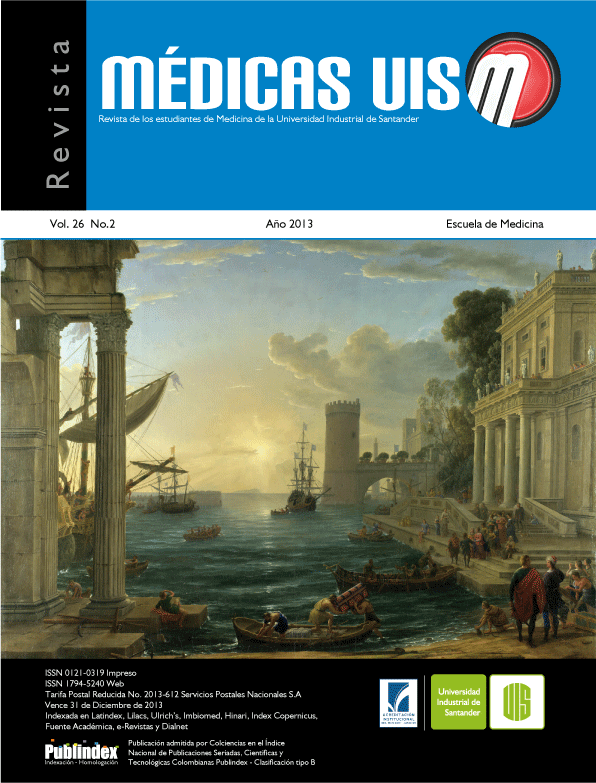Abstract
Hypertension is an increasing health problem with a great impact on society as it is considered one of the leading causes of death and disability. A literature review was made in order to study the accessibility to mainly non-pharmacologic prevention and control actions for this morbid condition. Patient-related factors are beliefs, unawareness of the disease or strategies for its control. At the health services level, it was found that the main factors are related to health practitioners’ abilities to give education or to promote healthy life styles,
besides the organization of health institutions. Attention is called about the importance of the involvement of other society sectors to control this health issue, based on the fact that many proposed interventions go beyond the health services feld of action (MÉD.UIS. 2013;26(2):35-41).
References
2. The seventh Report of the Joint National Committee on prevention, detection, evaluation and treatment of high blood pressure. Hypertension. 2003;42:1206.
3. World Health Organization. Global status report on noncommunicable diseases. Italy: World Health Organization; 2010. p.176.
4. Bautista L, Vera-Cala L, Villamil L, Silva S, Peña I, Luna L. Factores de riesgo asociados con la prevalencia de hipertensión arterial en adultos de Bucaramanga, Colombia. Sal Pub Mex. 2002;44(5):399-405.
5. Observatorio de Salud Pública de Santander. Informe de morbilidad basado en Registros Individuales de Prestación de Servicios en Salud (RIPS) consulta externa. Bucaramanga: Observatorio de Salud Pública de Santander; 2009. p.7.
6. Observatorio de Salud Pública de Santander. Informe de morbilidad basado en Registros Individuales de Prestación de Servicios en Salud (RIPS) consulta externa. Bucaramanga: Observatorio de Salud Pública de Santander; 2008. p.1.
7. Frenk J. El concepto y la medición de accesibilidad. Sal Pub Mex. 1985;27(5):438-53.
8. Andersen R. Revisiting the Behavioral model and access to medical care: Does it matter? J. Health Soc. Behav. 1995;36(1):1-10.
9. Andersen RM. National Health Surveys and the Behavioral Model of Health Services Use. Med Care. 2008;46(7):647-53.
10. Andersen RM, Newman JF. Societal and Individual Determinants of Medical Care Utilization in the United States. The Milbank Quarterly. 2005;83(4):1-28.
11. Aday LA, Andersen R. A Framework for the Study of Access to Medical Care. Health Serv Res.1974;9(3):208-20.
12. Travassos C, Martins M. Uma revisão sobre os conceitos de acesso e utilização de serviços de saúde. Cad Saúde Pública. 2004;20 Suppl 2:190-8.
13. Gold M. Beyond coverage and supply: measuring access to healthcare in today’s market. Health Serv Res.1998 Aug;33(3 Pt 2):625-84.
14. Shengelia B, Tandon A, Adams O, Murray C. Access, utilization, quality and effective coverage: an integrated conceptual framework and measurement strategy. Soc Sci Med. 2005;61(1):97-109.
15. Rosenstock I, Strecher V, Becker M. Social learning theory and the health belief model. Health Educ. J. 1988;15(2):175-83.
16. Ministerio de la Protección Social. Guías de atención de la hipertensión arterial. Colombia: Ministerio de la Protección Social. p.68.
17. WHO CVD-risk management package for low – and medium-resource settings. Geneva: World Health Organization; 2002. p.38.
18. Wang L. Physician-related barriers to hypertension management. Med Princ Pract. 2004;13(5):282-5.
19. Crosson JC, Heisler M, Subramanian U, Swain B, Davis GJ, Lasser N, et al. Physicians’ perceptions of barriers to cardiovascular disease risk factor control among patients with diabetes: results from the translating research into action for diabetes (TRIAD) study. J Am Board Fam Med. 2010;23(2):171-8.
20. Labhardt ND, Balo JR, Ndam M, Grimm JJ, Manga E. Task shifting to non-physician clinicians for integrated management of hypertension and diabetes in rural Cameroon: a programme assessment at two years. BMC Health Serv Res. 2010;10:339-48.
21. Krousel-Wood MA, Muntner P, Islam T, Morisky DE, Webber LS. Barriers to and determinants of medication adherence in hypertension managemente: perspective of the cohort study of medication adherence among older adults. Med Clin North Am. 2009;93(3):753-69.
22. Odedosu T, Schoenthaler A, Vieira DL, Agyemang C, Ogedegbe G. Overcoming barriers to hypertension control in African Americans. Cleve Clin J of Med. 2012;79(1):46-56.
23. Gladstone J, Howard M. Effect of advanced access scheduling on chronic health care in a Canadian practice. Can Fam Physician. 2011;57:21-5.
24. Zaitune M, De Azevedo M, Galvão C, Carandina L, Goldbaum M. Hipertensão arterial em idosos: prevalencia, fatores asociados e práticas de controle no municipio de Campinas, São Paulo, Brasil. Cad Saúde Pública. 2006;22(2):285-94.
25. Dearborn J, McCullough L. Perception of risk and knowledge of risk factors in woman at high risk for stroke. Stroke. 2009;40(4):1181-6.
26. Muñoz L, Cerezo M, González M, Paz A, Realpe C, Vélez C, et al. Accesibilidad a acciones de promoción y prevención de la salud y prevención de población hipertensa de Pereira, Colombia, 2008. La mirada del paciente. Investig Andina.2009;11(18):6-21.
27. Realpe C, González M, Vélez C, Cerezo M, Paz A, Muñoz LP, et al. Acceso al programa de hipertensión en el sistema general de seguridad social en salud, 2008.Hacia la Promoción de la Salud. 2008;13:195-209.
28. Papas M, Alberg A, Ewing R, Helzlsouer K, Gary T, Klassen A. The built environment and obesity. Epidemiol Rev. 2007;29:129-43.
